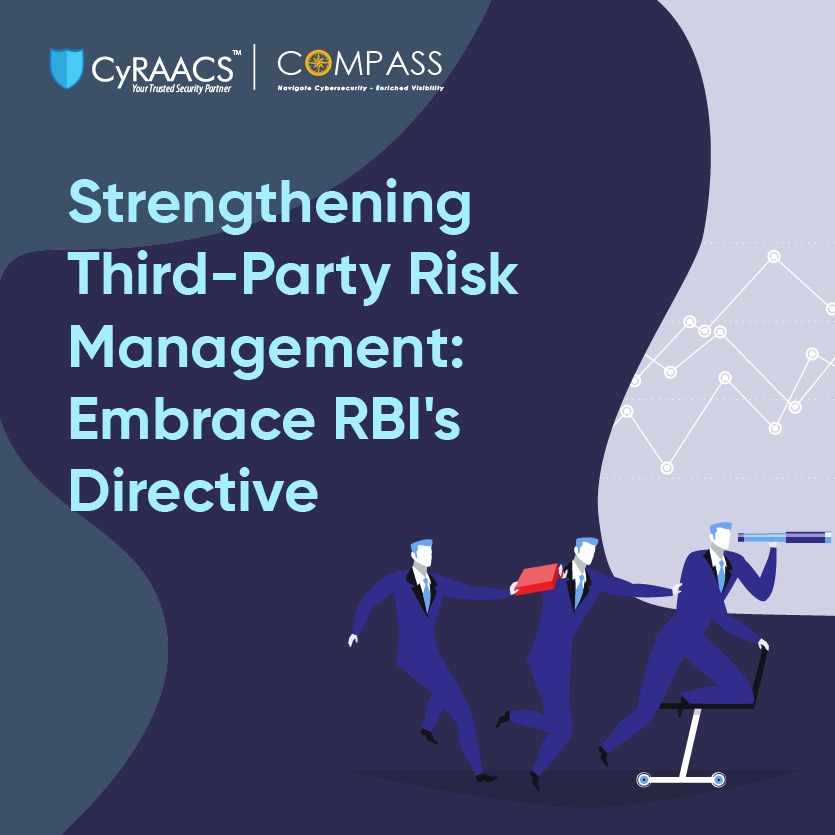In today's interconnected financial landscape, the reliance on third-party vendors has become increasingly prevalent, bringing both opportunities and risks. The Reserve Bank of India (RBI) has recognized the importance of robust Third-Party Risk Management (TPRM) systems to ensure the security and stability of financial institutions. Embracing the RBI's directive on TPRM is not merely about compliance; it's a strategic approach that enhances operational resilience and safeguards against potential threats. This guide aims to provide insights into the directive's key components and offers practical steps for organizations to strengthen their third-party risk management practices, ultimately fostering a more secure and trustworthy financial ecosystem.
While strengthening cybersecurity measures is essential, third-party risk management is often overlooked despite being a significant vulnerability. Many Large organizations including banks, NBFC & BFSI companies rely on third-party vendors for digital services, cloud computing, and payment processing, but these external partnerships can introduce security gaps.
Here are some key steps banks should take to mitigate third-party risks:
- Robust Vendor Assessment – Conduct thorough due diligence before onboarding vendors, ensuring they meet security and compliance standards.
- Continuous Monitoring – Regularly audit third-party systems for vulnerabilities, rather than relying on one-time security checks.
- Contractual Security Clauses – Ensure vendor agreements include strict cybersecurity requirements, data protection policies, and incident response obligations.
- Zero Trust Framework – Implement access controls and segmentation to minimize exposure in case of a vendor breach.
- Incident Response Coordination – Align security protocols with third-party partners to ensure quick response to cyber threats.
- With the RBI tightening its cybersecurity oversight, banks must go beyond internal defenses and ensure their entire digital ecosystem, including vendors and partners, is secure.
COMPASS by CyRAACS is a powerful solution that can significantly enhance Third-Party Risk Management (TPRM) by automating and streamlining critical risk assessment processes. As the Reserve Bank of India (RBI) tightens cybersecurity oversight, banks must adopt robust TPRM frameworks to mitigate risks posed by third-party vendors.
How COMPASS Enhances TPRM
- Automated Vendor Risk Assessment – COMPASS automates the entire vendor assessment lifecycle, reducing manual efforts and ensuring continuous monitoring of third-party risks.
- Risk Scoring & Prioritization – The platform assigns risk scores based on vendor responses, helping banks focus on high-risk vendors and take proactive actions.
- Regulatory Compliance Alignment – COMPASS ensures that vendor assessments comply with RBI cybersecurity guidelines, DPPB, ISO 27001, NIST, and PCI-DSS standards.
- Real-Time Monitoring & Alerts – The platform continuously tracks vendor security postures, sending real-time alerts on potential risks or compliance breaches.
- Centralized Vendor Risk Dashboard – Provides a comprehensive risk view across all third-party vendors, simplifying risk governance and decision-making.
- Automated Remediation Workflows – Helps banks enforce remediation plans with third parties, ensuring quick resolution of security gaps and compliance issues.
With RBI’s heightened cybersecurity scrutiny, adopting COMPASS can empower banks with a scalable, automated, and regulatory-compliant TPRM strategy. This ensures that third-party vendors do not become the weakest link in cybersecurity defenses.
Conclusion
In conclusion, adopting RBI's directives on Third-Party Risk Management is essential for organizations striving to navigate the complexities of today’s financial environment. By taking proactive steps to identify, assess, and mitigate risks associated with third-party relationships, institutions can protect themselves from vulnerabilities that can lead to operational disruptions or reputational damage. As the financial sector continues to evolve, implementing a comprehensive TPRM framework not only ensures compliance with regulatory obligations but also builds confidence among stakeholders. Embracing these guidelines positions organizations to thrive in a landscape where third-party relationships are integral to success, fostering a culture of diligence and accountability that benefits the entire ecosystem.
Use Case: Strengthening Third-Party Risk Management (TPRM) for a Fintech Payment Solutions Provider Using CyRAACS COMPASS
Background
A leading fintech company providing payment solutions to banks and merchants was facing challenges in managing third-party cybersecurity risks. With RBI tightening its cybersecurity oversight, the company needed an automated, scalable, and compliant TPRM framework to assess and monitor the security posture of its vendors, including cloud providers, payment processors, and technology partners.
Challenges Faced
- Complex Vendor Ecosystem – The fintech provider relied on multiple third-party vendors, including cloud services, fraud detection tools, and API integrations, making risk assessment challenging.
- Regulatory Compliance Risks – The company needed to ensure compliance with RBI guidelines, PCI-DSS, ISO 27001, and NIST for secure payment processing.
- Lack of Continuous Risk Monitoring – Vendor security audits were conducted only annually, leaving gaps in real-time risk tracking.
- Slow Incident Response – Without an automated workflow, responding to third-party security incidents was delayed, increasing exposure to cyber threats.
- Data Privacy & Secure Transactions – The fintech provider had to ensure that third-party vendors adhered to data protection policies to prevent fraud and data breaches.
Solution: Implementing COMPASS
- Automated Third-Party Risk Assessments – COMPASS streamlined the vendor onboarding and risk evaluation process, reducing assessment time by 70%.
- Regulatory Compliance Mapping – The platform ensured that third-party vendors complied with RBI, PCI-DSS, GDPR, and ISO 27001 security standards.
- Real-Time Vendor Risk Monitoring – COMPASS continuously monitored vendor security postures, providing real-time alerts on vulnerabilities and potential data breaches.
- AI-Driven Risk Scoring – Vendors were automatically assigned risk scores based on their security maturity, prioritizing high-risk vendors for immediate action.
- Automated Incident Response – Security incidents involving third-party vendors triggered automated remediation workflows, reducing risk resolution time by 50%.
- Centralized Risk Dashboard – The fintech provider gained a comprehensive view of vendor risks, allowing proactive risk management and quick regulatory audits.
Key Outcomes
- Faster third-party risk assessment, reducing manual efforts by 70%.
- Enhanced compliance with RBI, PCI-DSS, and ISO 27001 security mandates.
- Real-time monitoring of vendor security, reducing fraud and payment fraud risks.
- 50% faster incident response, improving payment security and fraud prevention.
- Stronger vendor governance, ensuring fintech partners meet security and data protection standards.
By adopting COMPASS by CyRAACS, the fintech provider automated and strengthened its Third-Party Risk Management (TPRM), ensuring a secure, compliant, and resilient payment ecosystem.

